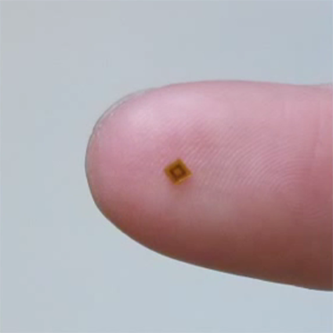

A lot of patients can benefit from continuous blood pressure monitoring, but inflatable arm cuffs are currently the only reliable method to do so. Attempts are currently underway by a number of organizations to use pulse wave transit time obtained through single lead ECG to provide cuffless blood pressure monitoring, but clinical level precision may not be achieved any time soon with this technique. A new solution may come in the form of a tiny wireless implant, only one millimeter on a side and 0.1 mm thick, that’s been developed by engineers at Stanford University.
The device consists of a layer of squishable tiny pyramids sandwiched between two copper coils set on top of a flexible substrate. The coils act as an antenna that can be electrically resonated by an external radio signal. The resonance induced signal that comes back can be measured using the same external device. As the pressure around the implant goes up, the copper coils are pushed closer together, lowering the resonant frequency. This change is detected in real time, providing a reliable indicator of the pressure around the implant. Besides measuring blood pressure, the device has great potential for continuous wireless intracranial pressure monitoring, which the research team demonstrated successfully in laboratory mice.
Here’s a quick overview of the new pressure sensor technology:
Study in Nature Communications: Continuous wireless pressure monitoring and mapping with ultra-small passive sensors for health monitoring and critical care…
Press release: STANFORD TEAM INVENTS SENSOR THAT USES RADIO WAVES TO DETECT SUBTLE CHANGES IN PRESSURE…
